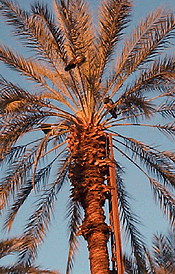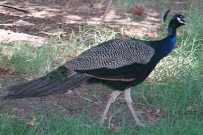

| HOME PAGE | This month in the fields at Brown Date Garden |
Mail-order sales and price list |
Packing house hours & directions |
Comparison chart of dates |
| Pollination process | Deglet Noor harvest |
| ||
Medjool, Barhee, and Deglet Noor date trees — We're still cleaning the palms by removing the branches which once held dates, a task we started in December. We're also still removing thorns from newer palm fronds. Each palm frond is lined on two sides with needle-sharp thorns that range from two to six inches in length. By January, many of the thorns are dry and brittle, and they can puncture tractor tires and steel-belted tires. We are very careful with these thorns!
Peacocks and peahens — The peacocks' back feathers have grown long, and they display and shake their colorful plumage when trying to attract female attention. They also try to get female attention by squawking loudly, and may even get into fights with other males.
Medjool, Barhee, and Deglet Noor date palms — In February, we start the date palm pollination process. See below for photos of the pollination process.
Peacocks and peahens — The peacocks' back feathers are still long, and mating season continues.
Medjool, Barhee, and Deglet Noor date palms — We continue pollination; see below for photos of the pollination process.
Peacocks and peahens — The peacocks' back feathers are still long, and mating season continues.
| ||
Medjool, Barhee, and Deglet Noor date palms — We are still pollinating all the female date trees, a task we started in March; we repeat the process a second time for each palm because not all palm fronds grow at the same rate.
Also in April, we "thin" each Medjool strand by hand. Normally, we remove every other date (each date is now the size of a large pea) in order to produce a greater size date; the thinning process gives each date more sun and room to grow, and increases air circulation for the fruit. When thinning the Medjool date palms, each of our field workers does only 1-1/2 palms per day (keep in mind, our Deglet Noor date palms are about 55' to 60' tall, so it's a long way up to get to the fruit).
Peacocks and peahens — The peacocks still have their colorful back feathers, but they are not quite as active in mating. The peahens start laying their eggs, which are larger than chicken eggs and take about 28 to 30 days to incubate; a peahen can lay anywhere from three to 12 eggs. Usually, the peahens hide their nests in the shrubbery.
Medjool, Barhee, and Deglet Noor date palms — We are still thinning the Medjool date palms, a task we started in April. Normally, we remove every other date (each date is now the size of a large pea) in order to produce a greater size date. When thinning the Medjool date palms, each of our field workers does only 1-1/2 palms per day.
 See if you can find the birds hiding in this date palm. |
Medjool, Barhee, and Deglet Noor date palms — We climb each palm separating each date bunch so that the weight is distributed evenly about the top of the palm. We tie each bunch to a limb in order to keep it stationary and help support the weight of mature dates.
Peacocks and peahens — The baby peachicks are learning how to stay with their mother and not get lost. Brown Date Garden is a large piece of property, and the peachicks still need to learn how to avoid cars, etc.
| ||
Medjool, Barhee, and Deglet Noor date palms — We're busy wrapping large brown paper bags around each date bunch in order to keep off the rain (occasionally we see some rain in the desert), and also to deter birds, sunshine, and insects from ruining the soft mature dates. We wrap a nylon mesh bag around some date varieties; the nylon bags completely block out insects, dust, rain, and birds.
Our Deglet Noor date palms are about 55' to 60' tall. Each field worker can "bag" 14 palms per day; this requires climbing a 48' ladder from the ground to get to the bottom of the 20' ladder that is tied to the top of each 55'-60' Deglet Noor date palm.
Peacocks and peahens — More little peachicks running around. We'll try to take photos next summer and put them here.
| ||
Medjool date palms — We are still wrapping bags around each date bunch in order to keep off the rain, and also to deter birds, sunshine, and insects from ruining the soft mature dates.
Barhee date palms — Harvest begins in August for dates. We begin our harvest season with the Barhee date. This date when fully ripened is small, round, brown, and extremely sweet. But, when it is picked in a yellow, immature state, the fruit is called a Khalal date. It is semi-sweet, large, yellow, and crisp like an apple. We cut each date bunch and lower it to the ground by using ropes. We leave Khalal dates on the strand and pack them in 30-pound size boxes.
Deglet Noor date palms — We are still wrapping bags around each date bunch of Deglet Noor dates, a task we began in July.
Peacocks and peahens — The peacocks have no tail feathers and are melting in the desert heat. And when the weather is 126 degrees Fahrenheit, the tractor driver's shoes start burning.
| ||
Medjool date palms — We begin harvesting the Medjool dates, which we pick individually as each date ripens. We leave the unripened dates on the palm so they can fully mature and develop into a large, juicy date bursting with flavor. We will pick each palm from two to five times in order to harvest only those dates which are ready. We put the ripe Medjool dates into 1000-pound bins. Each of our field workers harvests eight palms per day.
To clean the Medjool dates, the packing house crew brushes and tumbles the dates, vacuums them to remove any dirt, and shakes the dates over a damp towel. Then the crew grades and packs the dates for retail sale.
Barhee date palms — We are finishing the barhee date harvest that we started in August.
Deglet Noor date palms — These dates will probably be harvested starting in October.
Peacocks and peahens — The peacocks have no tail feathers, and all the birds (and farm workers) are melting in the desert heat.
| ||
Medjool, Barhee, and Deglet Noor date palms — We harvest the Deglet Noor and Medjool date palms, as well as our other soft dates (photos of the Deglet Noor harvest below). Most soft dates are harvested individually and not cut off as a whole bunch. Soft dates are extremely delicate and crush easily if placed into large containers.
Peacocks and peahens — The peacocks have no tail feathers, and all the birds (and workers) are ready for the gorgeous desert winter.
Medjool, Barhee, and Deglet Noor date palms — We finish harvesting the Deglet Noors, which are our last dates to be harvested. We cut these by the bunch and lower them into large storage bins. See below for photos of the Deglet Noor harvest process.
Peacocks
 |
Medjool, Barhee, and Deglet Noor date palms — Having finished our harvest last month, this month we begin cleaning the palms by removing old branches that once held dates. We also remove thorns from newer palm fronds. Each palm frond is lined on two sides with needle-sharp thorns that range from two to six inches in length. When these thorns are new and green in color, they easily puncture clothing, boots, and skin. As they dry and become brittle, they puncture tractor tires and steel-belted tires. We take extreme care while removing thorns from the new growth of fronds.
Peacocks and peahens — The birds are happy they are not being roasted for Christmas dinner.
The pollination process
|
|||
|
|||
|
|||
|
|||
|
|||
We mix cotton balls with the pollen (taken earlier from the male palms) and swab each female stem. We then cover the date strands with a small bag in order to create heat for the stem. |
The Deglet Noor harvest
|
|
 Our Deglet Noor palms are about 55 to 60 feet tall. To climb each palm, we use a 48-foot ladder to get from the ground to the bottom of the 20-foot ladder that is permanently tied to the top of the palm. We have to move the 48-foot ladders from palm to palm. |
 We use knives forged from bulldozer springs. Our men spend about eight hours sharpening a new knife in order to make it razor sharp. |
 After cutting each bunch, we place it on a steel hook and lower it to the ground with a long rope. |
 The ground crew removes the bunch from the hook, which then goes up for the next bunch. |
 We open up the bunch to let any infested dates fall to the ground. If any seedlings grow from these dates, we treat them like weeds. Our palms are grown directly from palm offshoots only, to maintain fruit quality. |
 We shake the good dates loose so that they fall into the bin, which holds about 700 pounds of dates. Deglet Noor dates are hardy and not as susceptible to being crushed. |
Brown Date Garden's land-mail address = 69245 Polk Street, Thermal, CA 92274
Office phone =
E-mail address = here
Website address = http://www.browndategarden.com
Website design by Jamesette.com
Photos at top of page [left to right] = Empress dates, Yellow Barhee bunch weighing 124 pounds (more than twice the "average" size bunch), Medjool dates, some of our prize-winning dates at the annual Indio Date Festival, Deglet Noor dates, and our prize-winning citrus fruit.
All photos on this website were taken by Brown Date Garden staff; © 2012-2023 Brown Date Garden.